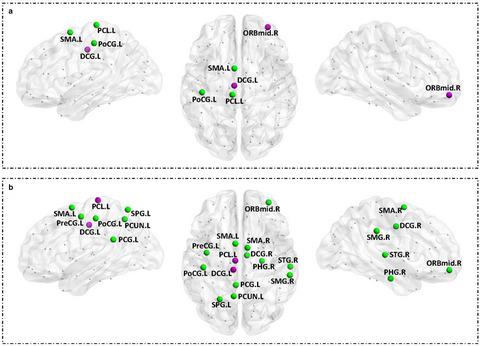当前位置:
X-MOL 学术
›
Eur. J. Neurosci.
›
论文详情
Our official English website, www.x-mol.net, welcomes your feedback! (Note: you will need to create a separate account there.)
Impaired frontal‐parietal control network in chronic prostatitis/chronic pelvic pain syndrome revealed by graph theoretical analysis: A DTI study
European Journal of Neuroscience ( IF 3.698 ) Pub Date : 2020-09-08 , DOI: 10.1111/ejn.14962 Xinfei Huang 1 , Jianhuai Chen 1 , Shaowei Liu 2 , Qingkuo Gong 1 , Tao Liu 1 , Chao Lu 2 , Zhan Qin 3 , Hongliang Cui 4 , Yun Chen 1 , Yongkang Zhu 5
European Journal of Neuroscience ( IF 3.698 ) Pub Date : 2020-09-08 , DOI: 10.1111/ejn.14962 Xinfei Huang 1 , Jianhuai Chen 1 , Shaowei Liu 2 , Qingkuo Gong 1 , Tao Liu 1 , Chao Lu 2 , Zhan Qin 3 , Hongliang Cui 4 , Yun Chen 1 , Yongkang Zhu 5
Affiliation

|
Chronic prostatitis/chronic pelvic pain syndrome (CP/CPPS) is characterized by chronic pain in pelvic area and lower urinary tract symptoms (LUTS). Previous neuroimaging studies demonstrated that chronic pain was associated with the altered brain activity. However, the pathological mechanisms associated with altered brain control of CP/CPPS are not well‐understood. Therefore, we sought to investigate the topological properties of white matter brain networks in patients with CP/CPPS and whether the topological configuration of frontal‐parietal control network was disrupted. We collected 19 patients with CP/CPPS and 32 matched healthy controls (HCs). Diffusion tensor imaging data of all participates were used to map the white matter structural networks. Graph theoretical method was applied to investigate the alterations of topological properties of brain network in patients. Moreover, we also investigated whether the alerted brain regions might be correlated with any clinical features of patients by the method of Pearson correlation analysis. Both CP/CPPS patients and HCs exhibited a ‘small‐world’ behavior or economical small‐world architecture of the white matter brain networks. In addition, CP/CPPS had a lower global efficiency in the right middle frontal gyrus (orbital part) and a higher global efficiency in the left middle cingulate and paracingulate gyri. CP/CPPS also showed increased local efficiency in the left middle cingulate and paracingulate gyri and paracentral lobule. Moreover, the local efficiency of the left middle cingulate gyrus was positively correlated with the scores of the influence of symptoms on the quality of life. The local efficiency of the left precuneus and right supplementary motor area were positively correlated with the total scores of NIH‐CPSI and the scores of pain and discomfort symptoms, respectively. Together, we found that patients with CP/CPPS had alterations of connections within the frontal‐parietal control network, which suggested that the altered connectivity involved in the executive control processing procedures might contribute to the pathogenesis of the pelvic pain and LUTS in CP/CPPS. Thus these results provided new insights into the understanding of CP/CPPS.
中文翻译:

图论分析揭示了慢性前列腺炎/慢性盆腔疼痛综合征的额顶控制网络受损:DTI研究
慢性前列腺炎/慢性盆腔疼痛综合征(CP / CPPS)的特征是盆腔区域慢性疼痛和下尿路症状(LUTS)。先前的神经影像学研究表明,慢性疼痛与大脑活动的改变有关。但是,与脑部控制CP / CPPS改变有关的病理机制尚不清楚。因此,我们试图研究CP / CPPS患者白质脑网络的拓扑特性,以及额顶控制网络的拓扑结构是否被破坏。我们收集了19位CP / CPPS患者和32位匹配的健康对照(HCs)。所有参与者的扩散张量成像数据被用来绘制白质结构网络的图。应用图论方法研究了患者脑网络拓扑结构的变化。此外,我们还通过以下方法研究了警报的大脑区域是否可能与患者的任何临床特征相关:皮尔森相关分析。CP / CPPS患者和HC均表现出“小世界”行为或白质大脑网络的经济小世界体系结构。此外,CP / CPPS在右中额额回(轨道部分)中具有较低的整体效率,而在左中扣带回和刺状回中具有较高的整体效率。CP / CPPS还显示左中扣带回和扣带回的回旋和中央小叶的局部效率增加。此外,左中扣带回的局部效率与症状对生活质量的影响得分呈正相关。左前神经和右辅助运动区的局部效率分别与NIH-CPSI总分,疼痛和不适症状分正相关。一起,我们发现CP / CPPS患者的额叶顶叶控制网络内的连接发生了改变,这表明执行控制处理过程中涉及的连接性改变可能会导致CP / CPPS盆腔痛和LUTS的发病。因此,这些结果为理解CP / CPPS提供了新的见识。
更新日期:2020-09-08
中文翻译:

图论分析揭示了慢性前列腺炎/慢性盆腔疼痛综合征的额顶控制网络受损:DTI研究
慢性前列腺炎/慢性盆腔疼痛综合征(CP / CPPS)的特征是盆腔区域慢性疼痛和下尿路症状(LUTS)。先前的神经影像学研究表明,慢性疼痛与大脑活动的改变有关。但是,与脑部控制CP / CPPS改变有关的病理机制尚不清楚。因此,我们试图研究CP / CPPS患者白质脑网络的拓扑特性,以及额顶控制网络的拓扑结构是否被破坏。我们收集了19位CP / CPPS患者和32位匹配的健康对照(HCs)。所有参与者的扩散张量成像数据被用来绘制白质结构网络的图。应用图论方法研究了患者脑网络拓扑结构的变化。此外,我们还通过以下方法研究了警报的大脑区域是否可能与患者的任何临床特征相关:皮尔森相关分析。CP / CPPS患者和HC均表现出“小世界”行为或白质大脑网络的经济小世界体系结构。此外,CP / CPPS在右中额额回(轨道部分)中具有较低的整体效率,而在左中扣带回和刺状回中具有较高的整体效率。CP / CPPS还显示左中扣带回和扣带回的回旋和中央小叶的局部效率增加。此外,左中扣带回的局部效率与症状对生活质量的影响得分呈正相关。左前神经和右辅助运动区的局部效率分别与NIH-CPSI总分,疼痛和不适症状分正相关。一起,我们发现CP / CPPS患者的额叶顶叶控制网络内的连接发生了改变,这表明执行控制处理过程中涉及的连接性改变可能会导致CP / CPPS盆腔痛和LUTS的发病。因此,这些结果为理解CP / CPPS提供了新的见识。



























 京公网安备 11010802027423号
京公网安备 11010802027423号